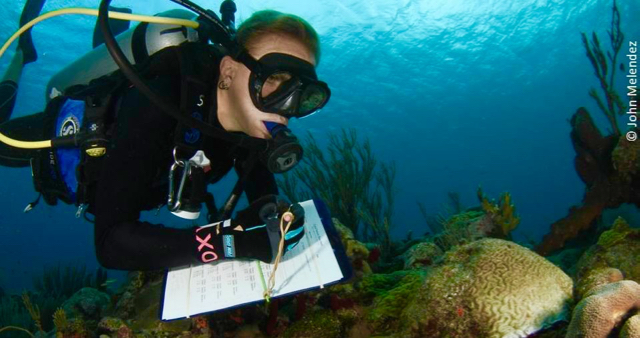
Lisa Terry, science technician and dive safety officer for The Nature Conservancy, made the training presentation on what residents need to know to become what she called “citizen scientists.”
BleachWatch is sponsored by The Nature Conservancy and falls under the umbrella of its Reef Connect program. The Reef Connect website was revamped in March and includes everything about BleachWatch, including Terry’s training presentation.
She said she was pleased with the way Monday’s event went.
“They asked very good questions and were excited. She added that everyone present took the underwater survey forms that the “citizen scientists” will need to fill out to be part of the program, she said.
For St. Croix residents who missed Monday’s training event, another will be held at 5:30 p.m. Tuesday at The Nature Conservancy in Little Princess. Residents of St. John and St. Thomas will get a presentation on BleachWatch Virgin Islands during the first part of the second week of September. Terry said September and October are the months when bleaching is most likely to occur.
In June the National Oceanic and Atmospheric Administration said a third consecutive year of higher-than-normal sea temperatures could lead to an increase in coral bleaching around the world and in the Virgin Islands.
According to Terry, high school interns performed surveys around St. Croix during July and reported no bleaching, but did find instances of coral disease. However, she indicated that a couple of reports of bleaching on deeper corals were received from volunteers who were trained in years past. Some scientists believe that deeper coral, being protected somewhat from the warming surface waters, are the key to coral reef survival.
Terry told the Source that divers at TNC have "noticed some paling in some of the deeper plate corals but haven’t seen any-wide spread bleaching this year.”
When asked what she hopes BleachWatch will accomplish, she explained, “Coral bleaching is largely due to warming waters from climate change and while we, on a local level, might not be able to stop climate change by ourselves, we can monitor and track these events as they happen to determine which reefs are more or less resilient to bleaching. Then we can use this knowledge to inform further conservation efforts, like the creation of protected areas or reducing pollution or overfishing in areas that are already susceptible to bleaching so as not to compound their stress.”
The survey sheet filled out by the citizen scientists is detailed and includes instructions such as “Estimate the percent coral coverage and other observations using the BleachWatch VI Data Sheet. Record any other findings (ex.: number and types of herbivorous fishes, number and types of invertebrates, number and types of diseases, etc.) using the notes section. Take photographs at each of your five survey stations and of any important observations or organisms.”
For residents who don’t want to get into such detail but would like to report reef damage, there is a quick report section on the BleachWatch page. When you get to the “quick report” feature, pin the map where you saw the disturbance and select from a list of disturbances, including coral disease, marine debris, and anchor damage.
“We hope that, if nothing more, the program encourages community members and visitors to pay attention to what’s happening on our reefs and inspire them to get involved with conservation efforts.”


